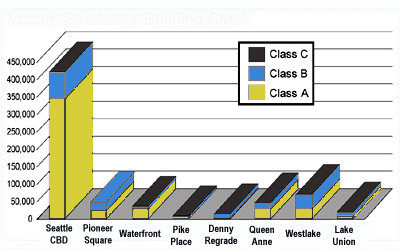|
Subscribe / Renew |
|
|
Contact Us |
|
| ► Subscribe to our Free Weekly Newsletter | |
| home | Welcome, sign in or click here to subscribe. | login |
Special Issues
| special issues index  February 24, 2000 | ||||
|
Dot-coms twist notion of supply and demand
It�s been said that nothing is permanent but change - an overstatement for this commentary on Seattle�s real estate resume. As one of a handful of active downtown brokers who experienced the office building boom of the 80s, the ensuing crash and burn of the early and mid 90s and the present robust market of the late 90s and early 00s, I can tell you that change (read: progress in spite of itself) is no accident. And change is definitely here to stay. Keeping up with Seattle�s real estate history has been like watching a Ken Burns documentary. The ups and downs of space and rates, the rise and falls of industrious developers. You can almost see the screen changing back and forth from a bleak black-and-white to technicolor as the 80s and 90s unfolded. Throw in a little mystery, intrigue and the occasional comedy and we get what? A happy ending? To be continued... but if the current wave of optimism is any indication, hang on for more theatrics and the wild ride. It�s easy to predict things once they�ve occurred, but should we turn back to the past for some clues to the future? Is history repeating itself? Are we destined to follow the same downward spiral as we did in the early 90s when office vacancy rates soared along with weekly announcements of landlord and developer bankruptcies? How about another S&L crisis? I believe the answer is a resounding: NOT LIKELY, but remember, I�m in an industry that wouldn�t exist without optimism. Look up and take note: we are now experiencing a stable real estate market, one that could be with us for a long time. The Seattle office vacancy rate has plunged during the last decade in the opposite direction of the S & P Stock Index while at the same time, rents have risen dramatically. Landlords are beaming because they are actually seeing returns on their investments. Developers are back in business, though the names and faces have changed, with auspicious projects ahead and a phenomenal preleasing market not seen before. Brokers are happy because they are not only assisting in the execution of numerous sales and leases in the present market but are, in some cases, negotiating leases that won�t even begin for a couple of years. This is due to the fact that some buildings have yet to be constructed. A fact that may not change anytime soon.
The wave of rising rents leaves behind whitecaps of despair for the prospective or renewing tenant sent reeling by rental sticker shock. Rents have climbed so quickly during the past four years that it is hard to remember when this new cycle started. Tenants have seen their rents double with little or no concessions being offered by non-sympathetic landlords. Office buildings outside the central business district are obtaining full service rents in the low to high $30s. A decade ago rents were closer to $12 to $14 in the same peripheral markets. As for the central business district, the $16 "effective" rental rate negotiated in the mid-rise section of Two Union Square a decade ago is now in the mid to high $30s. Rents have risen above the $40 range for the prime high-rise spaces and have the potential to continue to rise if and when the space comes available. The then typical $35 to $40 "turnkey improvement package" on newly constructed space is now effectively closer to $20 or less. The shell and core level finishes provided by the landlords are quite thin in comparison to what was provided during the 80s and early 90s. As much as $9 to $12 of a tenant improvement allowance can be eaten up in above ceiling costs, such as getting the HVAC distributed and electricity to the space, the lighting fixtures, ceiling grid, tiles and exterior mini-blinds purchased and installed. Tenants are now routinely paying out of their own pockets to fund additional required improvement costs. Landlords also do not have to amortize these extra costs, a common practice in the 80s and early 90s. For a clear perspective of the market statistics illustrating how the market has changed over the last decade, take a look at the accompanying graph. We�ve had our share of ups and downs. The drama unfolds. When I began my brokerage career in 1985 it was an exciting time to be in commercial real estate. The entire Puget Sound real estate community was teeming with confidence. Business journals read more like industry trade magazines covering the next high-profile real estate project on the horizon. High-profile developers, such as Martin Selig, Wright Runstad and Unico Properties, ruled over downtown Seattle. The names Mike Mastro, Basil Vysis, Lang Sly, Tom Bernard and Koll Development Co., were synonymous with Eastside development. Each new project seemed to be designed to upstage the preceding in grandness of scale. Imported marble and granite finishes, rare rain-forest hardwoods and ornate glass sculptures graced building lobbies and restrooms. The Seattle real estate "golden age" was blossoming and office space was "visualized" to reality. The Puget Sound region was beginning to emerge onto the national and international stage thanks in part to Boeing and a budding software company called Microsoft. The business climate was ripe for development along with available land, over abundant investment capital and the vision and talent of local, ardent developers. The supply for office space grew as quickly as the capital it attracted. And the plot thickened. Although we were seeing absorption rates in the seven-digit figures in the late 80s, the amount of new space being introduced into the market was coming on-line at a monstrous pace. A pace so fierce that it spurned a region wide successful grassroots anti-growth campaign. Ironically, a subsequent "Cap" initiative enacted in Seattle expedited the construction of more than 3 million square feet due to the threat of a significant suspension of existing permitted projects. This was clearly not in everyone�s best interest. Unfortunately for those invested in commercial real estate, either financially or by career choice, the national recession had finally reached Seattle. The seemingly limitless capital markets dried up and the US went to war with Iraq. This put many business decisions on hold and the demand for office space, in contrast to the vast supply of office space, was at a pace that resembled molasses on a cold winter�s morning. Vacancies reached a record high in 1989 with the completion of Two Union Square and Pacific First Centre (now the US Bank Centre). This was further increased by the completion of AT&T Gateway Tower in 1990 (now known as Key Tower and soon to be known as City Hall).
The early part of 2000 is similar in some ways to a decade ago. The Puget Sound real estate community is again overflowing with optimism. Our region is now a mainstay on the national and international commerce stage thanks to Boeing, the now monolithic Microsoft Corp., and the innumerable companies that call Seattle home. The Seattle office vacancy rate is at an all time low of 2.7 percent. It was closer to 16 percent in 1990. Rental rates continue to move higher. Downtown office rental rates increased in excess of 12 percent from a year ago. This is on top of more than 15 percent the previous year and 15 percent the year before that. The demand for office space is largely driven by an explosive growth of Internet-related companies, including the likes of Amazon, Getty Images, RealNetworks, F-5 Networks, Go2Net, Shopnow, WatchGuard and a batch of ambitious, well-funded startups. There are currently more than 2.3 million square feet under construction in the Seattle office market, 6.7 million if you include the Eastside and South End markets. Metropolitan Park North, Opus Center @ Union Station, Harbor Steps North, Pier 70, the Mercer Yale Building and more than 370,000 square feet in four buildings are Quadrant Lake Union Center are all 100 percent leased. The three-building 401 Elliott West project is 90 percent leased. These projects total approximately 1.5 million square feet alone. 505 Union Station and the Nordstrom Office Tower are both 80 percent preleased, adding another 826,948 square feet that should be fully leased by their completion dates. A decade ago, most tenants were unwilling to sign a lease until the building was close to completion. If the Seattle market continues to see million-plus square foot absorption figures as it has since 1997, vacancy rates will continue to remain low, between 2 and 5 percent for the next several years. If you�re wondering whether rents can continue to increase at rates near or above 10 percent each year, travel to San Francisco to see where it is headed. Better yet, hop onto the Web and try to keep up with dot-com explosion. It adds a whole new dimension to the notion of supply and demand. This real-life, real estate documentary is still under construction. It re-invents itself daily and the edits are numerous with the cast and crew changing constantly as the audience widens. It�s Oscar-winning material. Things are looking very sunny for the Puget Sound Real Estate community as we end the 20th century and begin the 21st. Now if we could just get the weather to cooperate.
Leigh Callaghan is a senior vice president with Colliers International. He has been a commercial real estate broker specializing in downtown Seattle office leasing and sales for 14 years.
|


